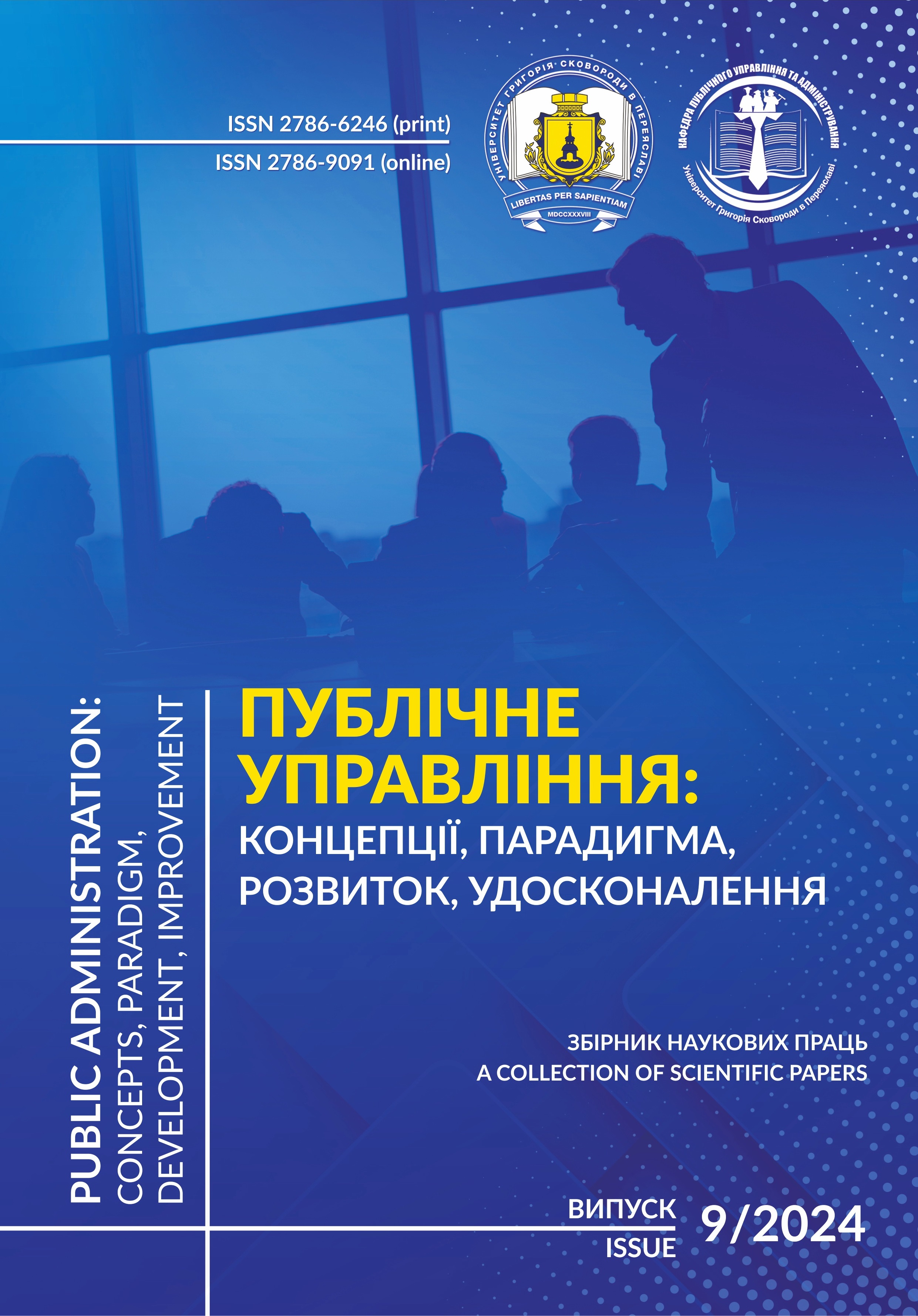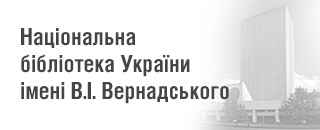CRITICAL REVIEW OF THE METHODS OF ASSESSING THE EFFICIENCY OF FUNCTIONING OF PUBLIC AUTHORITY BODIES
DOI:
https://doi.org/10.31470/2786-6246-2024-9-107-122Keywords:
public authority, efficiency, efficiency assessment, methods of efficiency assessmentAbstract
The article examines methods for assessing the efficiency of public authority bodies as a key element of democratic governance.
The authors analyze the importance of such assessments for increasing transparency, accountability, and flexibility in government activities, which contribute to the socio-economic development of civil society.
The study demonstrates that efficiency assessments allow for identifying problematic aspects of public authorities' work, optimizing resource use, and ensuring compliance with legislative norms. It is noted that the lack of a unified evaluation methodology complicates achieving a comprehensive analysis of efficiency. Instead, various approaches are suggested, including the DEA algorithm, digital technology-based evaluations, and theoretical models such as rational bureaucracy and life cycles. However, each of these methods has its shortcomings, such as limited scope, lack of integration, difficulty in practical application, and ignoring social and regional aspects.
The authors also discuss the main approaches to evaluation, including leadership, economic accountability, and professionalism, emphasizing that effective management depends on considering various factors and societal needs.
The shortcomings of current legislative acts and official methodologies regulating evaluations are highlighted, particularly the need for systematicity and feedback mechanisms for implementing changes.
A comparative analysis of the most common models – 3Es, IOO, and BSC – allowed the authors to conclude that the BSC model is the most advantageous among the considered alternatives, as it best takes into account the needs of various stakeholders and allows for the consideration of both short-term and long-term perspectives by the accepted long-term mission and strategy of state formation.
As a result of the study, proposals were put forward for creating a coherent and practically oriented evaluation methodology that would consider the specific aspects of the activities of public authorities and provide mechanisms for implementing the results of the evaluations. The article concludes that the development of such a methodology is crucial in enhancing the efficiency of public authorities' functioning and meeting the needs of citizens.
References
Guan, Q., Zou, S., Liu, H., & Chen, Q. Performance Evaluation Method of Public Administration Department Based on Improved DEA Algorithm. https://doi.org/10.1155/2022/2338680 [in English].
Krejnus, M., Stofkova, J., Repkova Stofkova, K., & Binasova, V. (2023). The Use of the DEA Method for Measuring the Efficiency of Electronic Public Administration as Part of the Digitization of the Economy and Society. Applied Sciences, 13(6), 3672. https://doi.org/10.3390/app13063672 [in English].
Batalli, M. (2015). Measurement and evaluation of the public administration performance through delivery of electronic services. Academicus International Scientific Journal. Retrieved from oai:dspace.epoka.edu.al:1/1517 [in English].
Zlenko, A., Redzyuk, V., Lyashchenko, Yu., & Zlenko, Ya. (2024). Tendentsii ta perspektyvni napriamy pobudovy ekosystemy upravlinnia personalom derzhavnoi sluzhby. Publichne upravlinnia: kontseptsii, paradyhma, rozvytok, udoskonalennia, (8), 55–65. https://doi.org/10.31470/2786-6246-2024-8-55-65 [in Ukrainian]
Pikulyk, O.I., & Vlasiuk, N.I. (2023). Osnovni pidkhody do otsiniuvannia efektyvnosti diialnosti orhaniv derzhavnoho upravlinnia. Vcheni zapysky TNU imeni V.I. Vernadskoho. Seriia: Publichne upravlinnia ta administruvannia. https://doi.org/10.32782/TNU-2663-6468/2023.1/17 [in Ukrainian]
Bazyka, S.K. (2018). Pidkhody do otsiniuvannia efektyvnosti publichnoho upravlinnia u svitovii praktytsi. Publichne upravlinnia i administruvannia v Ukraini, 4, 30-35. Retrieved from http://pag-journal.iei.od.ua/archives/2018/4-2018/8.pdf [in Ukrainian].
Sementsova, O.V., Palamarchuk, I.V., & Starykova, S.O. (2021). Metody otsinky efektyvnosti derzhavnoho administruvannia ta mistsevoho samovriaduvannia. Publichne upravlinnia ta mytne administruvannia, 1 (28), 53-57. https://doi.org/10.32836/2310-9653-2021-1.8 [in Ukrainian].
Ofitsiinyi sait Verkhovnoi Rady Ukrainy. Pro zatverdzhennia Metodyky provedennia otsinky efektyvnosti zdiisnennia orhanamy vykonavchoi vlady kontroliu za vykonanniam zavdan, vyznachenykh zakonamy Ukrainy, aktamy Prezydenta Ukrainy, postanovamy Verkhovnoi Rady Ukrainy. Postanova KMU. zakon.rada.gov.ua. Retrieved from https://zakon.rada.gov.ua/laws/show/522-2011-п#Text [in Ukrainian].
Ofitsiinyi sait Verkhovnoi Rady Ukrainy. Poriadok ta Metodyka provedennia monitorynhu ta otsinky rezultatyvnosti realizatsii derzhavnoi rehionalnoi polityky. Postanova KMU. zakon.rada.gov.ua. Retrieved from https://zakon.rada.gov.ua/laws/show/856-2015-п#Text [in Ukrainian].
Yedynyi veb-portal orhaniv vykonavchoi vlady Ukrainy. Monitorynh ta otsinka efektyvnosti diialnosti holiv oblasnykh ta Kyivskoi miskoi derzhadministratsii. kmu.gov.ua. Retrieved from https://www.kmu.gov.ua/diyalnist/regionalna-politika/monitoring-ta-ocinka-efektivnosti-diyalnosti-goliv-oblasnih-ta-kiyivskoyi-miskoyi-derzhadministracij [in Ukrainian].
Vebsait NAPK. Normatyvni osnovy. Metodolohiia otsiniuvannia koruptsiinykh ryzykiv u diialnosti orhaniv vlady. wiki.nazk.gov.ua. Retrieved from https://wiki.nazk.gov.ua/category/anticcoruption-upovnovazhenym/koruptsijni-ryzyky-ta-antykoruptsijni-programy/1-antykoruptsijna-programa-organiv-vlady/normatyvni-osnovy-1-antykoruptsijna-programa-organiv-vlady/ [in Ukrainian].
Vogel, R., & Werkmeister, L. (2021). What is Public about Public Leadership? Exploring Implicit Public Leadership Theories. Journal of Public Administration Research and Theory, 31(1), 166–183. https://doi.org/10.1093/jopart/muaa024 [in English].
Araya-Orellana, J.P. (2022). Assessment of the Leadership Styles in Public Organizations: an Analysis of Public Employees Perception. Public Organiz Rev, 22, 99–116. https://doi.org/10.1007/s11115-021-00522-8 [in English].
Hart, P. ‘t. (2011). Evaluating public leadership: towards an assessment framework. Public Money & Management, 31(5), 323–330. https://doi.org/10.1080/09540962.2011.598338 [in English].
Dzhurova, A. (2020). Organization Theory, Bureaucracy, and Public Management in a Time of Transformation. In: Farazmand, A. (eds). Global Encyclopedia of Public Administration, Public Policy, and Governance. Springer, Cham. https://doi.org/10.1007/978-3-319-31816-5_4126-1 [in English].
Kettl, D. F. (2022). Weberian Bureaucracy and Contemporary Governance. Perspectives on Public Management and Governance, 5(2), 111–120. https://doi.org/10.1093/ppmgov/gvab026 [in English].
Nasi, G., Cucciniello, M., & Degara, V. (2018). Evaluation of Innovation Performance in the Public Sector: A Systematic Review of Studies. In: Borgonovi, E., Anessi-Pessina, E., Bianchi, C. (eds) Outcome-Based Performance Management in the Public Sector. System Dynamics for Performance Management, 2. Springer, Cham. https://doi.org/10.1007/978-3-319-57018-1_11 [in English].
O’Toole, L. J. (2017). Implementation for the Real World. Journal of Public Administration Research and Theory, 27(2), 376–379. https://doi.org/10.1093/jopart/muw071 [in English].
Jacob, S. (2023). Evaluation and Policy Evaluation. In: van Gerven, M., Rothmayr Allison, C., Schubert, K. (eds) Encyclopedia of Public Policy. Springer, Cham. https://doi.org/10.1007/978-3-030-90434-0_15-1 [in English].
Hassel, A., & Wegrich, K. (2022). How to Evaluate Policies. How to Do Public Policy. Oxford: Oxford Academic. https://doi.org/10.1093/oso/9780198747000.003.0006 [in English].
Methods Of Measuring The Economy, Efficiency And Effectiveness Of Public Expenditure. www.cepal.org. Retrieved from https://www.cepal.org/sites/default/files/project/files/annex_7_methods_of_measuring_economy_efficiency_and_effectivenes.pdf [in English].
Pedrosa, G. V., Kosloski, R. A. D., Menezes, V. G. d., Iwama, G. Y., Silva, W. C. M. P. d., & Figueiredo R. M. d. C. (2020). A systematic review of indicators for evaluating the effectiveness of digital public services. Information, 11, 472. https://doi.org/10.3390/info11100472 [in English].
Sarker, M. N. I. (2019). Public administration as a professional practice. В: Farazmand A. (eds) Global encyclopedia of public administration, public policy, and governance. Cham: Springer. https://doi.org/10.1007/978-3-319-31816-5_3853-1 [in English].
Shikova, N. (2020). Competency-based management in public administration. В: Farazmand A. (eds) Global encyclopedia of public administration, public policy, and governance. Cham: Springer. https://doi.org/10.1007/978-3-319-31816-5_3923-1 [in English].
Monitorynh i otsiniuvannia upravlinskoi diialnosti: konspekt lektsii / uklad.: H.A. Mishenina, Ya.V. Kobushko (2022). Sumi: Sums’kyi derzhavnyi universytet. essuir.sumdu.edu.ua. Retrieved from https://essuir.sumdu.edu.ua/bitstream-download/123456789/88097/1/Mishenina.pdf [in Ukrainian].
Mansurjonovich, M.K. (2022). Methods for assessing the efficiency of management at the current stage of state development. Middle European Scientific Bulletin, 20, 61–67. https://doi.org/10.47494/mesb.2022.20.1018 [in English].
Measuring public administration users’ guide for public administration performance. www.researchgate.net. Retrieved from https://www.researchgate.net/publication/233188984_The_3E_methodology_for_developing_performance_indicators_for_public_sector_organizations [in English].
Liu, W. B., Cheng, Z. L., Mingers, J., Qi, L., & Meng, W. (2010). The 3E methodology for developing performance indicators for public sector organizations. Public Money & Management, 30(5), 305–312. 10.1080/09540962.2010.509180 [in English].
Otrusinova, M., Pastuszkova, E. (2012). Concept of 3 E’s and public administration performance. International Journal of Systems Applications, Engineering & Development, 2, 6, 171-178. Retrieved from https://naun.org/main/UPress/saed/16-119.pdf [in English].
Vignieri, V. (2018). Performance management in the public sector. В: Farazmand A. (eds) Global encyclopedia of public administration, public policy, and governance. Cham: Springer. https://doi.org/10.1007/978-3-319-31816-5_3480-1 [in English].
Kinyuira, D., Kenyatta, J. (2019). Using results chain framework as a tool for the improvement of performance evaluation in firms. Journal of Strategy & Performance Management, 7, 28–36 [in English].
Gębczyńska, A., Brajer-Marczak, R. (2020). Review of selected performance measurement models used in public administration. Administrative Sciences, 10(4), 99 [in English].
Kaplan, R. S., Norton, D. P. (2001). The strategy-focused organization: How balanced scorecard companies thrive in the new business environment. Boston: Harvard Business Press [in English].
Nechaeva, I.A., & Tsintyla, I.V. (2023). Modeli otsiniuvannia efektyvnosti publichnoho upravlinnia. Innovatsii dlia vidrodzhennia: natsionalnyi, rehionalnyi, mizhnarodnyi kontekst. Zaporizhzhia: NU “Zaporizka politekhnika. Retrieved from https://eir.zp.edu.ua/server/api/core/bitstreams/e61a94d9-f5fc-4dfb-9566-498aabf91172/content [in Ukrainian].







